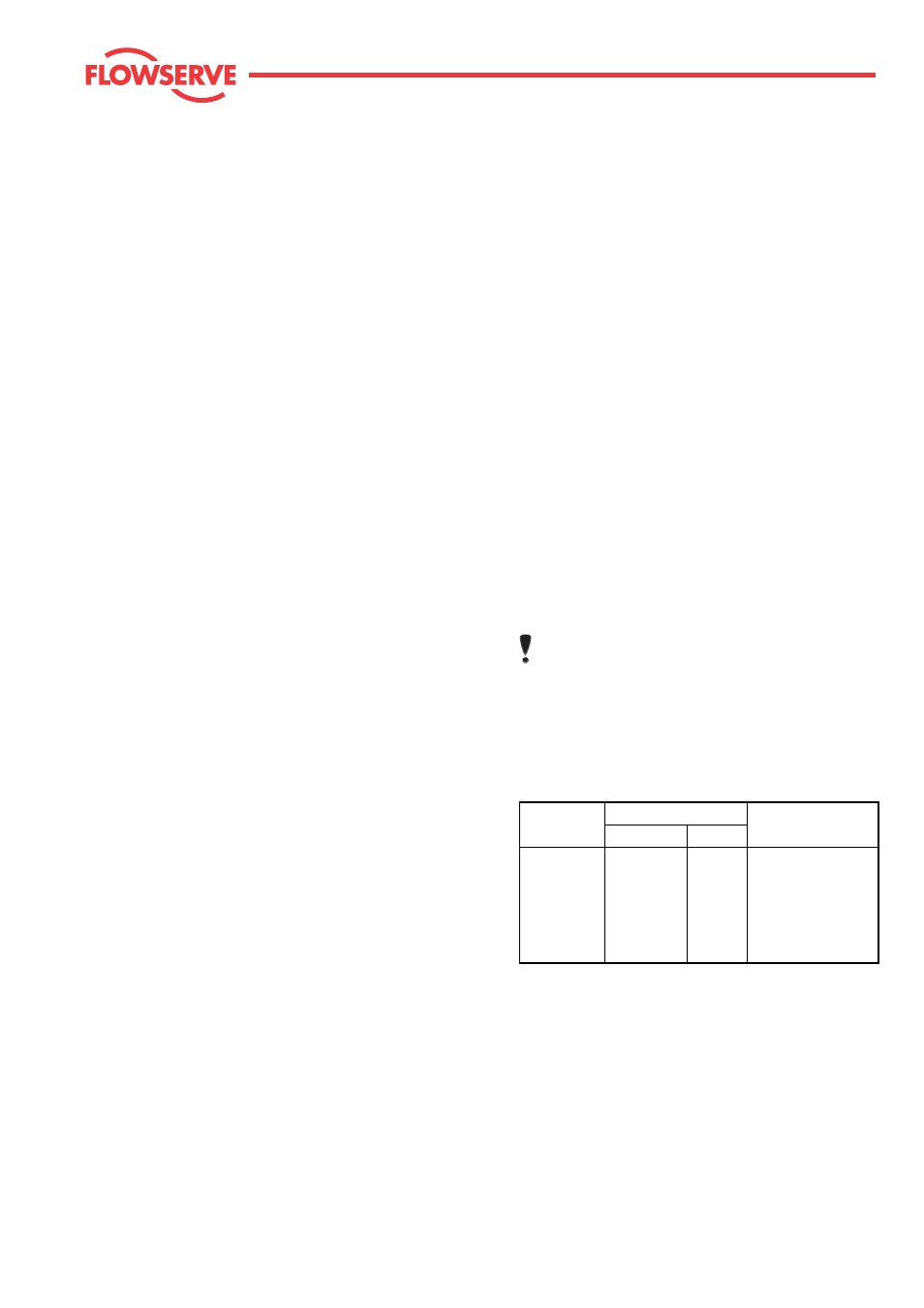Kammer control valves – Flowserve 4 Series Kämmer Pneumatic and Electropneumatic Actuators User Manual
Page 19

19
Flow Control Division
Kammer Control Valves
8.1.4
Using the range adjusting screw set the actuator to full
stroke + 1.5 mm (e.g. stroke 20 + 1.5 mm = 21.5 mm).
8.1.5
Make adjustment with the range adjusting screw as
required until desired stroke is obtained
8.2
Zero adjustment
3.2.1
The zero adjustment can only be set after the final
range adjustment has been made.
8.2.2
Maintain the low end signal (e.g. 0.2 bar or 4 mA) and
turn the zero adjustment locknut until it just makes
contact with the actuator housing.
8.3
Calibrate actuator
(actuator with adjustable positioner spring)
See nameplate for signal range, supply pressure and
stroke.
8.3.1
Connect air supply to the "SUPPLY" port of the actua-
tor and an adjustable signal source to the "SIGNAL"
connection. Attach a dial gauge to the actuator (see Fig
14).
8.3.2
Undo the zero adjustment locknut until it is a few
threads free of the actuator housing.
Loosen the set screw and thread the adjusting nut on
the actuator stem until it's lower face is in alignment
with the appropriate type designation on the gauge.
8.3.3
Set the signal to the low end value (e.g. 0.2 bar or 4
mA). Adjust the dial gauge to zero.
8.3.4
Set the signal to the high end value (e.g. 1.0 bar or 20
mA).
8.3.5
Using the range adjusting screw set the actuator to full
stroke + 1.5 mm (e.g. stroke 20 + 1.5 mm = 21.5 mm).
8.3.6
Set signal and dial gauge to zero.
8.3.7
Set the signal to the low end value. Adjust the posi-
tioner spring adjusting nut to compress/decompress
the positioner spring until the actuator stem rises 1.5
mm.
8.3.8
Set the signal to the high end value (e.g. 1.0 bar or 20
mA). Using the range adjusting screw set the actuator
to full stroke + 1.5 mm (e.g. stroke 20 + 1.5 mm = 21.5
mm).
8.3.9
Repeat adjustments 8.3.3 to 8.3.8 until both adjust-
ments are correct.
8.3.10 Set signal to zero and tighten the set screw in the
adjusting nut. Set the signal to the low end value. Set
the dial gauge to zero and tighten zero adjustment
locknut, until the dial gauge pointer just moves (nut
contacts the actuator housing) and then a further 1/4
turn ( around
3
/10 mm pretension).
8.3.11 Check all adjustments for correctness.
8.4
Calibrate actuator/valve
8.4.1
Connect air supply to the "SUPPLY" port of the actua-
tor and an adjustable signal source to the "SIGNAL"
connection. Undo the zero adjustment locknut until it
is a few threads free of the actuator housing. Attach a
dial gauge to the actuator and set it to zero.
8.4.2
Determine the instrument signal at which the plug
should begin moving off the seat and apply that signal
to the valve. If the plug stem does not begin to move
at the predetermined signal, adjust the signal to
midrange until the plug is off the seat, loosen the plug
stem locknut and turn the plug stem in or out of the
actuator stem.
For example, if the plug begins to move at a lower
signal than the predetermined one, turn the plug stem
out of the actuator stem. If the plug begins to move at
a higher signal than the predetermined one, turn the
plug into the actuator stem. Repeat this process until
the actuator is calibrated as required and re-tighten
the plug stem locknut. Adjust the zero adjustment
locknut until it is 2 mm off the actuator and replace the
actuator cap.
NOTE:
Do not turn the plug stem when the plug is
seated; otherwise, the plug and seat ring may be
damaged.
8.5
Calibrate actuators without a positioner
8.5.1
With no air supply to the actuator, adjust the zero
adjustment locknut until dimension "A" as shown in
the table below is achieved.
Actuator Stroke
Dimension “A”
Inch
mm
47
3
/
8
10
35
47
3
/
4
20
25
48 / 49
3
/
8
10
55
48 / 49
3
/
4
20
45
48 / 49
1
1
/
2
40
25
49D
1
1
/
2
40
55
size
(mm)
